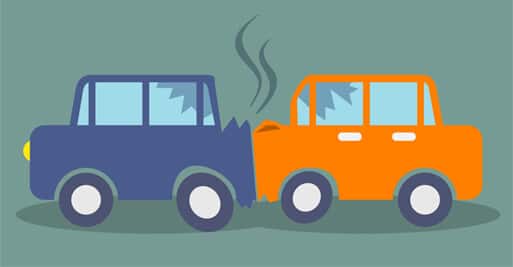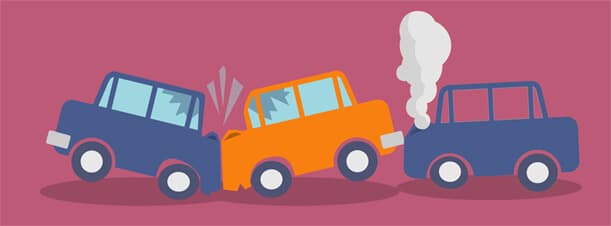So you were a recent victim of an automobile accident and now have questions you want to ask a Dallas car accident attorney. Should you talk to the opposing party’s insurance adjuster? Do you have a strong claim? These are all questions that may be running through your head, and you are about to get answers to them just by reading this article.
Four Factors Used to Gauge the Strength of an Automobile Injury Claim
Accident victims frequently ask what determines the strength of a personal injury claim arising from an automobile collision. Four that should be given particularly strong weight (among the many others):
- 1.) Liability:
- Which party caused the collision and who was at fault in the eyes of the law (i.e., the Texas Transportation Code, or another statute) is one of the most important factors determining the strength of a personal injury claim. The weaker the liability, the weaker the claim.
Rear-end crashes:

Rear-end collision occur when one vehicle collides with a car right in front of it. Rear end crashes are caused when the vehicle ahead suddenly breaks or otherwise slows down, and the car following fails to decelerate to compensate for the car in front of it. Injuries can often be severe and usually involve whiplash. These cases tend to be some of the easiest cases to settle with insurance carriers because they are often considered to be “clear liability.” “Clear liability” means that the circumstances and facts relating to the cause of the accident are so obvious against a party, the insurance company does not bother to contest who is at fault but instead contests the “damages” or medical injuries the plaintiff suffered as a result. The most common rear-end accidents occur when a driver is stopped at an intersection and is subsequently struck from the rear by another driver who just wasn’t paying attention and failed to slow down. Police reports involving these types of accidents will indicate that one driver was at fault and was either following too closely or simply inattentive.
A checklist of the liability issues to think about for rear-end cases:
- What was the position of the plaintiff’s car before to the accident? Stopped in traffic, waiting
for the traffic light to change, slowing down for traffic, waiting to turn left or right, or waiting
in a parking lot? - What was the speed of the Defendant’s vehicle when it collided with the Plaintiff.
- Did the plaintiff use a turn signal, and if so how soon did the plaintiff turn on the signal?
- The extent of the property damage. Was it minimum, moderate, or extreme? (Police reports
will describe the damage and the exact location, and pictures should also be obtained). - What statements were made at the time by the defendant and the plaintiff to the
investigative police officer at the accident scene? - Were there any other independent witnesses?
Intersection & Failure-to-Stop
Usually, these type of collisions are referred to as side impact, “T-bone,” or “broadsided” collisions. They are caused when one vehicle collides with the side of another vehicle. Damages to a vehicle and injury to occupants is usually much more severe compared to rear-end collisions. Safety features and other variables such as airbags, the quality of the materials used in the construction and structure of the vehicle, crumple zones, and speed of the vehicles can be game changers.

These types of claims can be a lot more difficult to settle with insurance companies than fender benders. The reason is that they often have multiple variables that make these cases more complex. Some of these include:
- The defendant usually denies liability and changes up the facts when giving statements to the police and his or her insurance adjuster;
- It’s often difficult to obtain witnesses that will support a plaintiff’s theory since they are typically in other vehicles and often drive off without giving contact information to investigating police;
- Police often arrive at different conclusions regarding fault without proper investigation.
Liability checklist for Intersection and failure-to-stop cases:
- Plaintiffs should typically obtain police reports as soon as possible to learn how the officer investigating the collision decided the factual cause of the accident and the liability of the parties.
- Plaintiffs or their counsel should read the Texas Transportation Code and other statutes which conceivably apply to the accident. The Texas Transportation Code has all the complicated rules regarding intersections, yielding to traffic, turning in traffic that likely would apply in these cases.
- If statements were not recorded by investigating police officers, then a private investigator should be retained to interview any witnesses that were present at the scene of the accident. Statements made by defendants can be used against them in trial as “admissions.”
- The scene of the accident should be visited, and pictures also taken so that the accident can be better visualized. Learning about the positions of the vehicles before and after the accident, locations of the street signs, as well as traffic lights can be vital to an investigation.
- If possible, photos of the should also be obtained depicting the positions of the vehicles, skid marks, positions of traffic lights, as well as damage to vehicles and bodily injuries sustained. Ideally, these pictures should be obtained as soon as possible so that the scene is not changed. These pictures will be helpful during pre-litigation negotiation, mediation, depositions, and ultimately trial. It will signal to the insurance adjuster and opposing counsel that the plaintiff is well prepared for whatever obstacles that may appear.
- The exact weather and road conditions should be determined at the time of the collision. This can help determine if they were others factors in play that may have caused the accident.
- Were any of the parties involved under the influence of any illegal substance, or prescription drug? Drugs can have a detrimental effect on the liability of a particular party.
- Counsel for the Plaintiff should determine whether there was any mechanical defect that caused the collision. Often insurance carriers attempt to raise the issue of a sudden unknown mechanical defect to ambush the Plaintiff.
Multi-Vehicle Pile Ups:

These are collisions involving numerous vehicles that often are caused by a single negligent driver who fails to keep a proper distance and rear-ends another vehicle. A chain reaction often ensues as other vehicles traveling at high speeds on freeways and highways do not have sufficient time to break and crash into the vehicles ahead of them. These types of collisions are extremely dangerous as drivers and passengers are hit multiple times.
- 2.) Damages:
- In personal injury claims, damages are the amount of money to be paid to a victim as compensation for injury or loss. Generally speaking, the greater the damages, the greater the value of the claim. Damages are usually broken up into compensatory (actual) or punitive damages (discussed in further detail below).
Compensatory damages:
Entitle a person to “be made whole” or to restore the person as much as possible to his or her preinjury condition through monetary payment. Compensatory damages are further broken up into general and special damages.
Special Damages:
These are all economic or out-of-pocket- losses sustained by an injury that can be documented by bills, invoices, canceled checks, credit card statements, and business/wage records. More generally, they can include medical expenses and loss of income.
General Damages:
These are non-economic losses that are a result of the injury and are not quantifiable. They compensate for “pain and suffering” as well as emotion distress arising from an injury. They can also compensate for disfigurement, disability, impaired enjoyment of life, shortened life expectancy, and susceptibility to future injury.
Punitive Damages:
These are monetary awards that are meant as a way to punish a tortfeasor and set an example for others. The goal here is not to compensate a victim. Punitive damages are awarded when a Plaintiff shows by clear and convincing evidence that a Defendant engaged in reprehensible conduct.
Does the potential defendant have the ability to pay?
The depth of the pockets of the Defendant is a very important factor to look at. Even if an injury victim has sustained serious injuries and has established liability the ability to recover may be seriously impaired if the Defendant has no means of paying. Before a claim is commenced the background of the Defendant should be evaluated, along with the insurance policy information (if known). If the Defendant does not have any insurance and or source of income/assets, does the claimant have uninsured motorist coverage? These issues can often put an injured person in a pickle if there is no one to collect from.
List of sources of payment for a personal injury claimant:
- The Defendant’s automobile liability, home owner’s liability, or umbrella policy;
- The automobile policy issued to the employer of the Defendant if the Defendant was operating a company motor vehicle, or was operating a vehicle in the course of employment when the accident occurred;
- The claimant’s uninsured or underinsured motorist policy (UIM Policy) if the potential Defendant was actually uninsured or underinsured;
- If the claimant was a passenger in the vehicle, the uninsured/underinsured carrier policy for the vehicle;
- The automobile policy which was issued to the owner of the car, if the owner of the car is someone other than the Defendant, and the owner granted permission to the Defendant to drive the car.
- The Defendant’s assets (this assumes the Defendant owns property, is employed, or is financially established).
- Any other source of income that can be unearthed through investigation.
Is the potential defendant “bad?”
A “bad” defendant is one that a fact finder would be more inclined to hold culpable for an accident. An example might be a drunk driver, or possibly a truck driver who is in a rush to make a delivery and has ignored traffic laws.
A “good” defendant meanwhile is a person who a fact finder is less inclined to hold responsible because of the context of the accident or the background of the person. An example of a “good” defendant maybe an elderly driver who did not make a full stop while volunteering for a non-profit. An example of a “bad” defendant is a group of teens that racing while drunk. Defendants who are jerks benefit Plaintiff’s personal injury claims, meanwhile, if the defendant is viewed as being “good” or “neutral,” then the jury may be sympathetic to them to the detriment of the Plaintiff.